It is an unfortunate dichotomy that the smallest guns that are most frequently carried for self-defense are often the ones that are the least likely to have many, if any, light options.
Today, I’m reviewing the Streamlight TLR-6 – a weapon-mounted light that hopes to bring much-needed illumination to the micro-gun market.
Many modern full-size handguns have accessory rails that open up a wealth of options for white lights. But the tiniest guns – those often carried in the pockets or waistbands of people just trying to defend themselves – are underserved by the tactical lighting industry.
When lights and/or lasers are made for subcompact pistols, the units tend to be either bulky or underpowered. Consider the recent introduction of the Taurus Curve. The integral lights used in those pistols put out only a meager 25 lumens. This is hardly any brighter than the tiny keychain light in my pocket and far inferior to the tiny Streamlight ProTac 1AAA flashlight that puts out nearly three times as much light.
Fortunately, Streamlight introduced a weapon light for the Glock 42 and Glock 43 pistols that is bright, very compact and affordable. Like the company’s TLR-2 and TLR-4 series lights, the TLR-6 also includes a red aiming laser to augment the standard Glock sights. [Ed. note: Since I wrote this article, Streamlight expanded the TLR-6 line to include most subcompact pistols.]
Quick Takeaways
– 100% reliable in all testing
– reasonably priced
– best weapon mounted light on the market for the micro-gun niche
I’ve had a TLR-6 for several years now, and I have been pleased with its performance. As with any light, there are compromises that have to be made when shrinking the size down. However, Streamlight did an exceptionally good job with the size envelope with which it had to work. I encourage you to read through the review, but I’ll give those of you in a hurry the bottom line now: I recommend it for anyone who carries a subcompact pistol for self-defense.
General Information
The TLR-6 is a combination of a white light and a red laser that mounts on the trigger guard of the Glock 42 and 43 pistols. The unit is housed in a black plastic case, and when installed, maintains the overall look and smooth flow of the pistol.
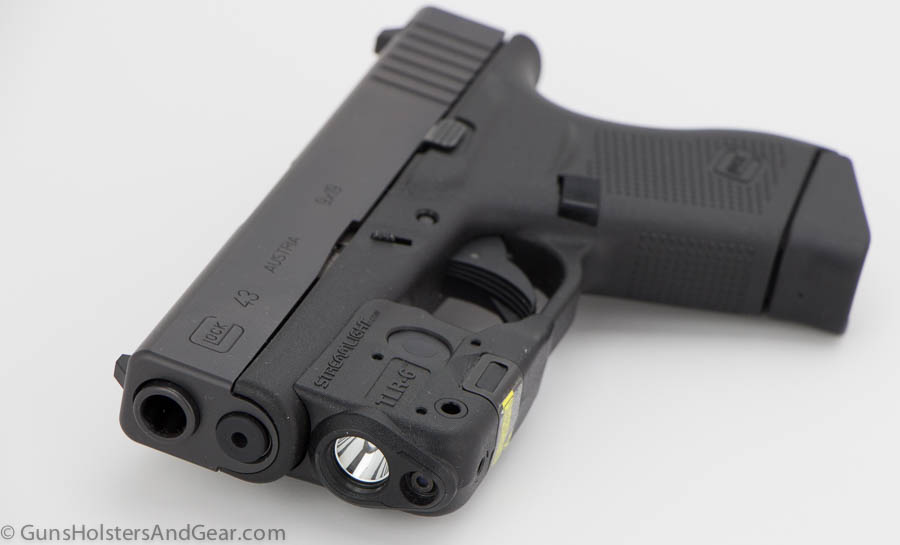
Like most modern tactical flashlights, Streamlight uses a LED for illumination. LED emitters offer a great balance of durability and efficiency. According to Streamlight, the light is rated at 100 lumens with a 2,000 candela peak beam intensity. More information on what I actually measured for output and runtime can be found in the testing section below.
A pair of CR1/3N batteries operate the light. The specified runtime is 60 minutes with either the light alone or both the light and laser activated. My measurements came up a little short of that, but not unreasonably so. Details are in the Output Over Time section.
This light/laser is fairly lightweight. With batteries installed, the TLR-6 weighed 1.2 ounces on my digital postal scale.
Manufacturer Specifications
Here are the specs for the Streamlight TLR-6:
| weight (with batteries as stated by the manufacturer) | 1.27 oz |
| weight (with batteries as measured) | 1.20 oz |
| length | 2.3″ |
| width | 0.85″ |
| body material | polymer |
| impact resistance | 1 meter |
| water resistance | IPX4 (splash only) |
Laser
Streamlight uses a red laser for the TLR-6. Red lasers offer a good balance of power efficiency and small physical size. The trade off with red lasers is that they are not easily seen in bright lighting conditions. At night, they work perfectly. In nearly all conditions other than outside daylight, red lasers are very useable.
I found the laser on this unit was very bright and completely useable in nearly all lighting conditions. Indoors, it was very easily seen with all of the lights on and sunlight streaming in through open windows.
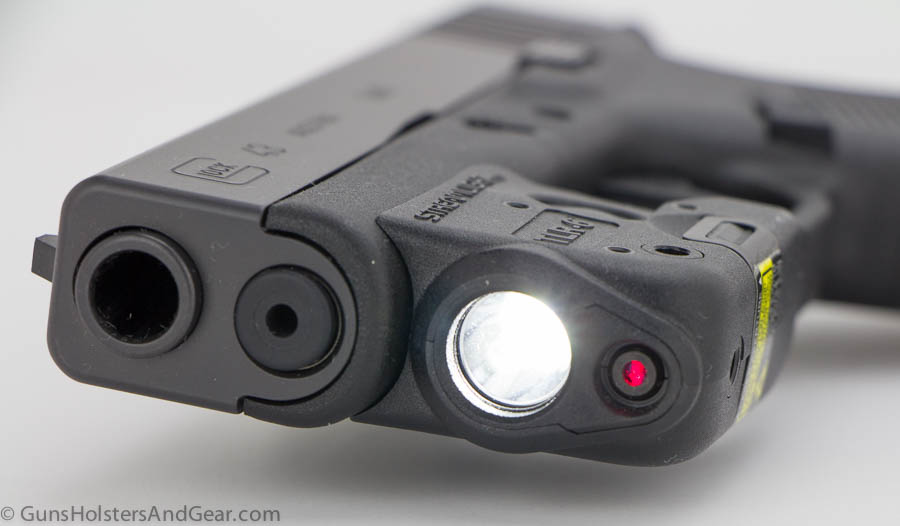
Remarkably, outside in direct summer sunlight, the laser was still useable. Some surfaces, such as a black car bumper, did not reflect enough of the laser in direct sunlight to be useful for rapid target acquisition. However, many surfaces – including a number of different colored shirts I tried – were reflective enough that the laser was more than adequate for aiming.
The company offers green lasers for other weapon lights in its catalogs but does not currently offer green for the G43. Although more visible in brighter lighting conditions, green lasers tend to be both more expensive and require more physical space. It is possible we will see a green laser option later for the TLR-6, but I would not expect to see that for at least a year.
In an ideal world, I would choose to have a green laser. However, that is not an option, and the performance of this red laser was very good. I believe most people will be pleased by it.
Controls
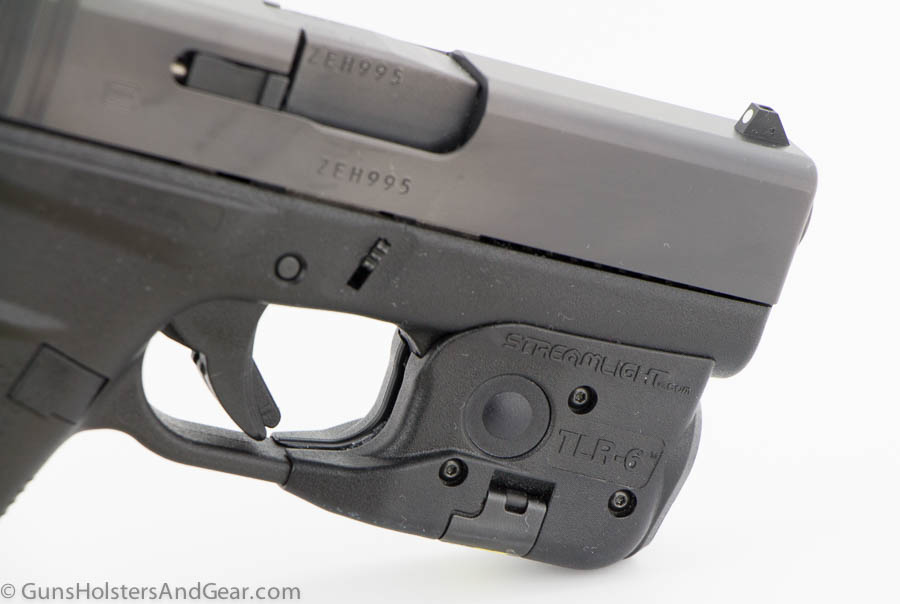
To control the TLR-6, there is a single button on either side of the housing. The buttons are large enough to be easily manipulated and are obvious to the touch. While I liked the LaserLyte TGL laser I tested on the G42, I did find the buttons on that unit were smaller than ideal. I much prefer the buttons on the Streamlight.
Pressing either button will activate the TLR-6. Holding one button down and pressing the opposite button will cycle through the available modes: laser only, light only or light and laser. Since it is unlikely that you would ever need (or want) to change modes during a critical incident, I think this control setup is ideal.
Installation
Installing the TLR-6 was very easy. The housing is split down the middle and secured together by three screws. To install the unit on an unloaded gun:
- Open the battery compartment and remove the batteries.
- Remove the three screws that secure the housing halves together.
- With the light/laser unit in one half of the housing, fit the two housing haves over the Glock trigger guard.
- Make sure the housing is properly aligned on the pistol and install the three screws you removed initially. Do not over tighten.
- Install batteries and close battery compartment.
As might be obvious at this point, batteries can be replaced on the TLR-6 without the need to remove the unit from the gun.
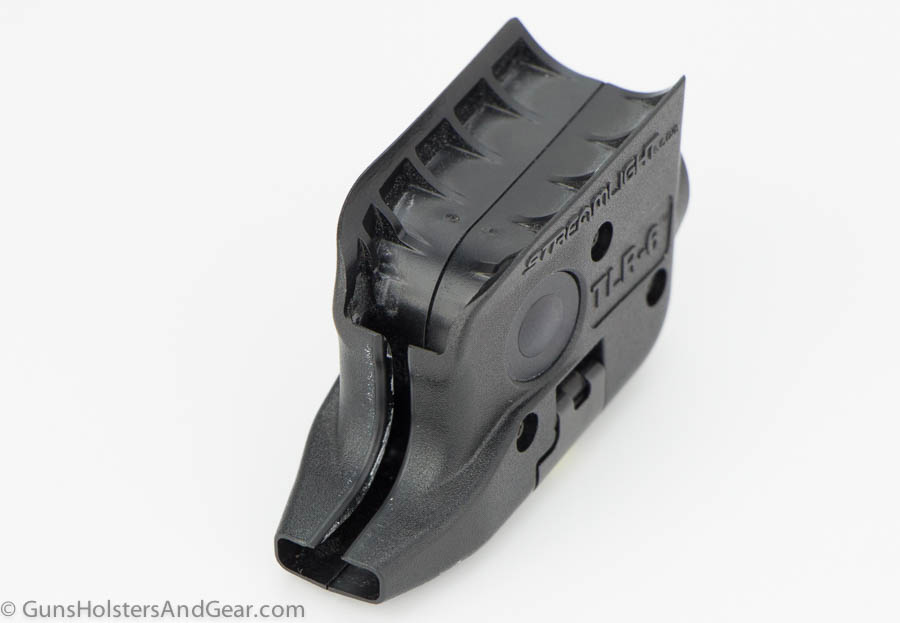
While not waterproof, the battery compartment hatch is very tight. It will not accidentally open on you. To swap the batteries on my unit, I had to use a small screwdriver to pry ever-so-lightly under the retaining latch to pop it open. Since I will not be changing batteries in the middle of a fight, I prefer to err on the side of caution as Streamlight did and have a very tight compartment that I know will not spring open unexpectedly.
Holster Options
There are many holster options for the Glock 43, but few for the G43 with an attached TLR-6. Few, however, does not mean none.
The good folks at YetiTac sent me a pair of holsters to test with the G43/TLR-6 combination. One was an IWB called the FireSide and the other was an OWB called the Quick Claw. Both holsters were well built and reasonably priced. I really liked the FireSide as it has a special feature to help tuck the butt of the gun into the body. Read the full review on the holsters here.
Additional options for the G43 with a TLR-6 include a Kydex holster from Badger Concealment and various models from CrossBreed.
Testing
The testing of flashlights and weapon lights has become something of a mission for me. Many flashlight companies have played with the numbers when advertising their gear, creating unrealistic expectations in the mind of the consumer.
When the ANSI/NEMA FL-1 standards were created, I had hoped they could be relied upon to give buyers an idea of what to expect from a flashlight. Unfortunately, those standards can be gamed and have not been enforced.
I created my own set of testing guidelines that every light that I review from July 2015 on will have to endure. These procedures are fully described on my flashlight review page here. In general, I test for:
- light output over time,
- the amount of heat generated by a light,
- impact resistance,
- water resistance, and
- range testing (for weapon mounted lights.)
Additionally, I provide photos of the light beam thrown using a standard distance with control photos. The standards are not perfect, but they are much better than guessing at light output or saying the light feels rugged. Follow the link above for the precise details of how I conduct these evaluations.
Output Over Time
On the packaging of most flashlights, you will typically see a measurement for output expressed in lumens and a runtime for a single set of batteries. Most people think that this means the flashlight will run at that output level for that length of time. Unfortunately, that is not true.
For the FL-1 standard, the output is the peak output measured between 30 seconds and 2 minutes from turning the light on. The runtime is how long the flashlight will emit light above a mere 10% of the peak number. It doesn’t take a genius to figure out these numbers can be gamed.
The following is the output I measured in my integrating sphere:
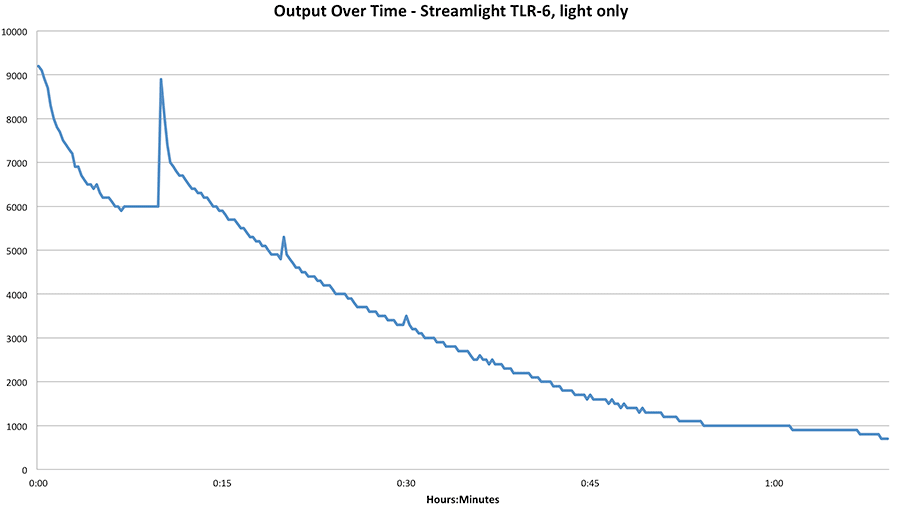
The TLR-6 has an automatic shut off at 10 minutes. The peaks in the output chart are the moments when I turned the light back on after it turned off. There were no more than 3 seconds between each shutoff and me turning the light on again.
The stated runtime for this light is one hour (to 10% of the peak output). To the same point, I measured 55 minutes, which I estimate to be within the margin of error in the testing equipment.
A more salient measurement is runtime to 50% peak. A 50% peak measurement is half of the light output from the start and is generally considered a point where many people will swap out batteries. For this light, the 50% peak runtime was 23 minutes.
Compared to other Streamlight flashlights, a 23 minute 50% runtime is a bit disappointing. Most of the company’s lights I have tested have a 50% runtime close to, or the same as, the 10% runtime.
While 23 minutes is not a long time, keep in mind that this is not a utility light. It is a very compact light designed for a specific application. You will not use this light very much outside of training, and 23 minutes of runtime in a single defensive shooting is probably much more than you would need.
For my needs, I deem the 23 minute runtime to be acceptable.
Heat Generation
One of the often overlooked aspects of modern tactical lights is the subject of heat generation. Some tactical lights are driving the LEDs very hard to produce a lot of light. That results in heat. How much heat can depending on the efficiency of the system as well as how much performance the designers are trying to wring out of the LED.
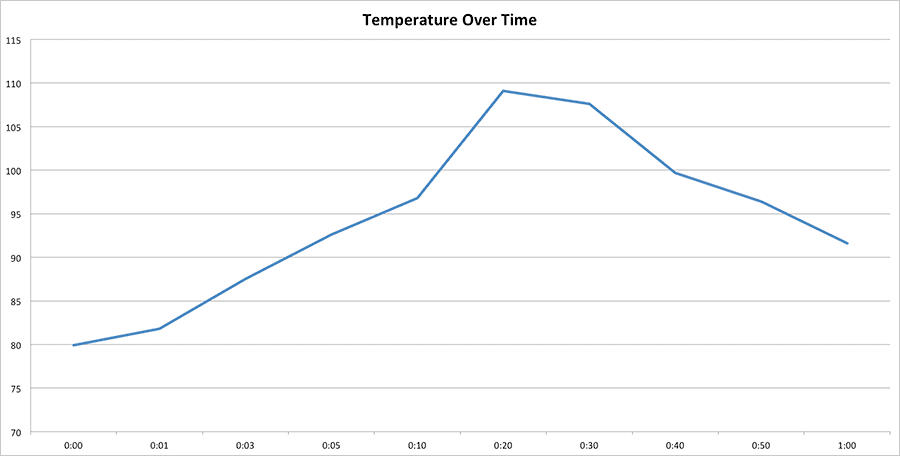
As you can see in the above chart, the surface temperature never got above 110° F. While warm to the touch, this is a cool running light compared to many of the tactical-type lights I have tested.
Visual Comparison
So, how does the beam pattern look on the TLR-6? Check out the before and after photos below. Use your mouse (or finger for those on touch-enabled devices) to move the slider back and forth. The two photos were taken moments apart using the same exposure settings.


In the above photos, the distance between the light and the target is 25′.
Drop Test
Streamlight states this light is impact resistant to 1 meter. Following my drop test procedures, I dropped the light six times onto hard concrete from a distance of 1 meter. The unit survived the drops with no impaired function.
I do want to note that the concrete impacts did very little cosmetic damage to the unit. While not perfect, the unit still looks very good and not abused.
Water Resistance
The TLR-6 is IPX4 rated. This means it is considered splash-resistant and not waterproof. Due to the nature of the assembly (clamping over the trigger guard,) it would be difficult to make the unit truly submersible. In the vast majority of incidents, waterproofing is not needed.
As the light is not designed or rated for submersion, I did not perform the standard pool test with this light.
Range Test
For the initial range test, I mounted the TLR-6 to a Glock 43 and aligned the laser to the point of aim through the sights at a distance of seven yards. From the factory, the laser was fairly close to center but needed a half turn for both windage and elevation to bring it to where I wanted.
At the range, I put 120 rounds through the gun. The first 100 rounds were Blazer Brass 115 gr FMJ loads and the final 20 rounds were Hornady Critical Duty 135 gr +P. The light and laser both functioned properly, and I did not observe any shift in the laser.
Since that initial testing, I’ve had the gun and TLR-6 to the range many times during the past several years. The light and laser continue to operate perfectly.
I swap the batteries out on a regular schedule to prevent them from going dead when I might need them. I’ve had precisely zero problems with any part of this process.
Final Thoughts
I recommend the TLR-6 for anyone wanting to add a light or laser to their Glock 42 or 43. It has some limitations, but so do those pistols. Both the guns and the lights are designed such that size is the overriding priority. Tiny sizes mean compromises.
Just as a Glock 43 will not take 15 rounds in the magazine, neither will the TLR-6 throw 500 lumens for 90 minutes. It just isn’t a realistic expectation.
The unit worked reliably and provided a good supplemental aiming tool. The white light is more than enough to properly identify a target in low light conditions. Based on my drop testing and range time, it seems the smallest of the Streamlight weapon lights is rugged enough for the job.
Additional good news: since I originally wrote this review, Streamlight now offers TLR-6 models for other guns including the Smith & Wesson Shield, Springfield Armory Hellcat, many Kahr pistols, and more.
Although the suggested retail price is $175, this tactical weapon light can be had for a lot less here. At these street prices, the TLR-6 is an excellent value.
Alternatives
At the time of this writing, there are no other light and laser combination units on the market for the G43. Other companies are making either light or laser units, but not a combo unit.
For lasers, both Crimson Trace and LaserLyte make aiming units that mount to the front of the trigger guard. I’ve not used the Crimson Trace, but I have reviewed the LaserLyte. The LaserLyte is not a bad unit, but it is inferior to the Streamlight product. For example, the side activation switches to are much smaller and harder to operate.
Last Update: August 5, 2021
Disclaimer
I believe in being completely transparent with my reviews. Many of my readers have come to rely on my reviews to guide them in making purchasing decisions. I value your trust, and I want you to know any of my potential biases so you can make an informed decision about how to invest your hard-earned dollars.
The TLR-6 reviewed here was provided by Streamlight for the express purpose of me doing a review. No offers or requests were made to do a positive review of the light. Streamlight has not paid me to write this review, and the company is not a sponsor or advertiser on this site. (Note: If a Streamlight ad shows up on this site, it is through an ad network like Google AdSense that automatically serves ads. I do not control what shows up there.)
GunsHolstersAndGear.com is a for-profit website. I do not charge readers a dime to access the information I provide.
Some of the links on this page and site are affiliate links to companies like Amazon and Palmetto State Armory. These links take you to the products mentioned in the article. Should you decide to purchase something from one of those companies, I make a small commission.
The links do not change your purchase price. I do not get to see what any individual purchases.
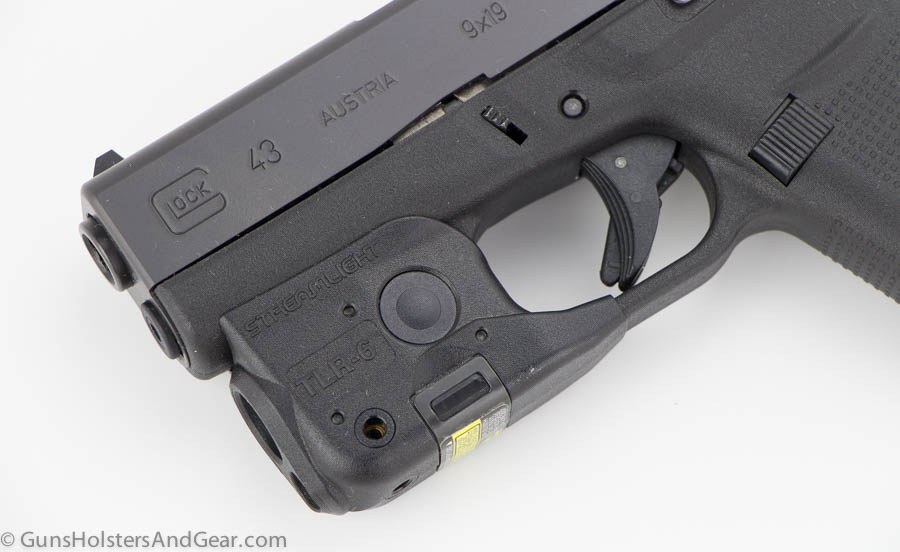
13 replies on “Streamlight TLR-6 Review”
Great review Richard, as always! I don’t know if you’re making a holster list for the TLR-6, but we do offer them. Right now we’re running a discount of $10 off IWB and OWB Holsters for the TLR-6. http://www.daraholsters.com/iwb-holster-for-glock-42-43-w-tlr-6
Awesome – Thanks for sharing the discount code!
Apparently the most updated version of this fits the shield and other subcompact pistols. Finally!
i really like the TLR-6! I managed to misplace the allen wrench, however. Could anyone tell me what size it is so I can get a replacement? I’ve searched a bit on line and can not seem to find the answer. Thanks!
The laser part stopped working, but flashlight still works
Streamlight would do well to make the light with a special slot to store the allen wrench.
Hello Richard. Nice review. Can you tell me if the TRL-6 fits the glock G28?
Hi Renato,
Here in the US, the G28 is restricted to law enforcement and government purchasers only, so I’ve never had the opportunity to shoot one. If they are the same size as the G26, then it should fit. If there are small differences in the dimensions of the gun, then it may not fit properly. I would recommend contacting Streamlight directly and see if they can offer additional guidance.
Best,
Richard
I would love to buy a kydex IWB left-hand holster for a Glock 21 with this laser light. I am not having any luck finding one. Do you have any insider secrets in the industry, that you could share? Thanks in advance!
Hi Eric,
I’d recommend talking to Dara Holsters & Gear. I’ve tested a few of their rigs in the past and found them comfortable and durable. I know they offer a lot of light options including the TLR-6. Even though I don’t see the G21/TLR-6 combo on their site, I suspect they can make you one if you talk to them directly.
-Richard
Can’t wait for a TLR-6G!!!
I have had a TL6 on a Sig P-365 for a while now with having put thousands of rounds thru it. I agree with most of your review. The TlR-6 is a good sight for the price and size. The only problem I have had is with the laser disappearing at the indoor range at 7 yards. I did notice that the flashlight lens was dirty from muzzle flash residue. I decided to clean it and did manage to finally get some of the residue off wit CLP. I also cleaned the laser lens and to my surprise it seems to show up much better. I will try it at the indoor range and see if it does in deed make a difference.
Update. After having had the TLR-6 for over a year and weekly range trips. I have decided that for the price and if you only need to use it indoors in a small area it may be fine for some. I use my weapon for self-defense, so I am a little more demanding. After using the TLR-6 at the range I encountered the following problems. 1) The laser was not bright enough at 7 yards. 2) At one point the laser wouldn’t come on. The problem seems to be with the switch. 3) after firing at the range, the laser Lense was dirty enough with powder residue that made the already difficult to see laser light that much harder to see. I am going to try the new TLR-8 that has a higher price but has a higher light output, a different switching set-up and the light/laser is a little future behind the muzzle. I have other streamlight, light/laser combos on other guns and am happy with them.